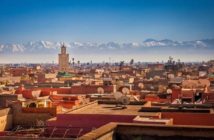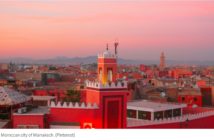Leave the enthralling but exhausting cities behind for a more agreeable pace in a couple of lesser-known gems.
Travellers on whistle-stop tours of Morocco often make the same mistake: cramming too much in, too quickly. The likes of Marrakech, Tangier and Fez are intoxicating places to visit. But their heady combination of heat, touts, sights and souks can quickly tire you out – especially if you see them one after the other.
For example, after a couple of fascinating, yet enervating, days exploring the exotic wonders of old Fez, I head to Chefchaouen, a gorgeous laid-back town nestled in a valley, surrounded by the craggy peaks of the Rif Mountains, one of four major chains that roll down to the Sahara Desert.It’s best to break things up by slotting a few more laid-back destinations into your Moroccan itinerary.
In 1492, Chefchaouen (or Chaouen) swelled with the arrival of Muslims and Jews fleeing the Spanish Inquisition. Christians were banned until the 1920s, when Spain colonised northern Morocco (France held the country’s other regions). Today, Chefchaouen welcomes everyone, particularly hikers, who use the town as a base to trek a clutch of scenic trails on the hilly outskirts, including one leading to Jebel el-Kelaa, a 1616m summit.
Dreadlocked hippies and backpackers also love it here, drawn by the copious amounts of hashish grown and sold locally. Others, like me, are simply happy to wind down in the town’s lovely little medina, which is characterised by blue-washed streets and buildings (a colour scheme inspired by Jewish tradition). Embedded into the medina’s walls is an array of antique, pottery and textile stores, where the sales pitches are gentle and silky smooth and come in variety of languages. Spanish is still widely spoken, along with French, Arabic and English, which Abdul, a loquacious indigenous Berber, uses to try to lure me into his rug emporium. He tells me that Mel Gibson was a previous customer. “Mel was here a few years ago, you know. He came into my shop. Will you come in too? We can have tea. Er, how do you say . . . no strings attached!”
Souvenir shopping isn’t on my agenda yet, so I politely decline and head to the central plaza, Uta el-Hammam. It has a striking red-hued kasbah (a citadel formerly home to sultans), a stunning mountain backdrop and a raft of cosy alfresco cafes and restaurants, where I spend hours quaffing freshly-squeezed orange juice, sipping sugary mint tea and watching the world go by.

Chefchaouen’s mountainous backdrop / Picture: Steve McKenna
If Chefchaouen is the go-to place from Fez (or Tangier – it’s almost halfway between the two), then Essaouira is the perfect escape from Marrakech.
About 180km west of the glamorous Red City, this artsy Atlantic coast town was settled way back by Phoenicians and Romans, who harvested a much-prized purple dye from the local mollusc.
While tourism is now a substantial earner for Essaouira – it has riad-hotels, galleries, cocktail bars, souvenir stores and a UNESCO World Heritage rating – it’s still very much a thriving fishing port. Against the backdrop of the town’s 15th century Portuguese fortress, I watch fishermen in colourful wooden boats coming ashore. You can buy their catches there and then, or purchase a feast in the medina market; say a red tuna or sea bass, or shrimps, which will be grilled and accompanied by salad, olives and bread. You can also dine at some pleasant cosmopolitan restaurants (including ones specialising in Italian, Spanish, Mexican and Asian fare).
I lap up Essaouira’s seafood because so far on my Moroccan trip I’ve mostly stuck to traditional dishes: tagines (braised stews of meat and vegetables served in sizzling clay pots), couscous (with chicken or beef) and brochettes (skewered kebabs), followed by ultra-sweet desserts like chabikiya, which are especially popular during the month of Ramadan.
After the commotion of Marrakech’s medina, Essaouira’s mellow old quarter is a pleasant surprise. Artisans sell woodwork, lacquerware and heaps of other colourful souvenirs, but you won’t get pestered too much, and there’s no motorised traffic, though you may have to dodge the odd donkey-drawn cart.
It’s a joy to stroll La Skala, the picturesque old sea walls and canonball-studded ramparts, which Orson Welles used for his 1949 adaptation of Shakespeare’s Othello. One of Essaouira’s squares is named after the American actor-director.
Welles’ compatriot Jimi Hendrix was another to fall for Essaouira’s charms. The guitarist came here in the mid-60s – but there’s apparently no truth to the rumour that a nearby beach inspired his bluesy song Castles Made of Sand.
Music runs through Essaouira’s veins – especially Gnawa (or Gnaoua), a genre that blends Berber, sub-Saharan African and Arabic tunes and rhythms, with acrobatic dances often colouring performances. These upbeat sights and sounds fuel the town’s annual Gnaoua and World Music festival (held each June). But you can get a flavour in the streets and bars all year round. On my last evening here, I stumble across a little show on La Skala. Moving past families and friends watching the sun begin its fiery descent into the Atlantic, I spot three musicians mystically chanting and strumming lutes.
As the muezzin’s call to prayer drifts from a mosque, and seagulls fly across a pinky-orange-tinted sky, the Gnawa trio build to a magnificent, spine-tingling crescendo. At times like this, Morocco is hard to beat.






